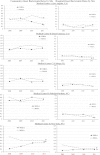Staphylococcus aureus bacteremia at 5 US academic medical centers, 2008-2011: significant geographic variation in community-onset infections
- PMID: 24879783
- PMCID: PMC4200044
- DOI: 10.1093/cid/ciu410
Staphylococcus aureus bacteremia at 5 US academic medical centers, 2008-2011: significant geographic variation in community-onset infections
Abstract
Background: The incidence of community-onset (CO) methicillin-resistant Staphylococcus aureus (MRSA) bacteremia rose from the late 1990s through the 2000s. However, hospital-onset (HO) MRSA rates have recently declined in the United States and Europe.
Methods: Data were abstracted from infection prevention databases between 1 January 2008 and 31 December 2011 at 5 US academic medical centers to determine the number of single-patient blood cultures positive for MRSA and methicillin-susceptible S. aureus (MSSA) per calendar year, stratified into CO and HO infections.
Results: Across the 5 centers, 4171 episodes of bacteremia were identified. Center A (Los Angeles, California) experienced a significant decline in CO-MRSA bacteremia rates (from a peak in 2009 of 0.42 to 0.18 per 1000 patient-days in 2011 [P = .005]), whereas CO-MSSA rates remained stable. Centers B (San Francisco, California), D (Chicago, Illinois), and E (Raleigh-Durham, North Carolina) experienced a stable incidence of CO-MRSA and CO-MSSA bacteremia. In contrast, at center C (New York, New York), the incidence of CO-MRSA increased >3-fold (from 0.11 to 0.34 cases per 1000 patient-days [P < .001]). At most of the sites, HO-MRSA decreased and HO-MSSA rates were stable. USA300 accounted for 52% (104/202) of genotyped MRSA isolates overall, but this varied by center, ranging from 35% to 80%.
Conclusions: CO-MRSA rates and the contribution of USA300 MRSA varied dramatically across diverse geographical areas in the United States. Enhanced infection control efforts are unlikely to account for such variation in CO infection rates. Bioecological and clinical explanations for geographical differences in CO-MRSA bacteremia rates merit further study.
Keywords: MRSA; Staphylococcus aureus; bacteremia; epidemiology; genotyping.
© The Author 2014. Published by Oxford University Press on behalf of the Infectious Diseases Society of America. All rights reserved. For Permissions, please e-mail: journals.permissions@oup.com.
Figures


References
-
- Jevons MP. “Celbenin”-resistant Staphylococci. British Med J. 1961;1:113–4.
Publication types
MeSH terms
Grants and funding
- R21 AI111760/AI/NIAID NIH HHS/United States
- UL1TR000124/TR/NCATS NIH HHS/United States
- K24 AI093969/AI/NIAID NIH HHS/United States
- K23 AI095361/AI/NIAID NIH HHS/United States
- UM1AI104681/AI/NIAID NIH HHS/United States
- UL1 TR000430/TR/NCATS NIH HHS/United States
- R01 AI103342/AI/NIAID NIH HHS/United States
- K24-AI093969/AI/NIAID NIH HHS/United States
- UM1 AI104681/AI/NIAID NIH HHS/United States
- R21AI111760/AI/NIAID NIH HHS/United States
- UL1 TR000124/TR/NCATS NIH HHS/United States
- R01 AI039108/AI/NIAID NIH HHS/United States
- AI-039108/AI/NIAID NIH HHS/United States
LinkOut - more resources
Full Text Sources
Other Literature Sources
Medical

